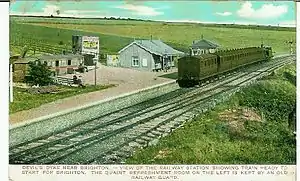Brighton and Dyke Railway
The Brighton and Dyke Railway was an independent railway copmpany which built a branch line from the West Coastway Line in East Sussex and West Sussex, England, at Aldrington. The line opened in 1887 and closed temporarily between 1917-1920. The railway was taken over by the Southern Railway in 1923.
 Dyke Terminus | |
| Overview | |
|---|---|
| Successor | Southern Railway (UK) |
| Technical | |
| Track gauge | Standard |
| Track length | 3.5 miles (5.6 km) |
Origins
By the 1870s Devil's Dyke had become a popular, if not easily accessible tourist attraction. Local businessmen wished to built a branch line from the London Brighton and South Coast Railway to the Dyke. Authorisation to build the line within five years was given 2 August 1877 (40 & $1 Vic. cap. 189).[1] However, there were delays in raising the requisite capital and building the line and the original act was extended by 44 & 45 Vic. cap 118 (18 July 1881), 49 Vic. cap. 45 (4 June 1886) and 50 & 51 Vic. cap.168 (8 August 1887). The line was opened 1 September 1887.
The route
The 3.5 miles (5.6 km) single track route ran from Aldrington near West Brighton station on the west coast line to The Dyke railway station which climbed from 100 feet (30 m) to 500 feet (150 m) in a series of reverse curves and a ruling gradient of 1 in 40.[2] There were originally no intermediary stations between West Brighton and the terminus. However, in 1891 the railway opened Golf Club Halt and in 1905 the LB&SCR opened Dyke Junction Halt at Aldrington, close to the branch line. In 1933 the Southern Railway opened Rowan Halt to serve a nearby housing development.
Operation
The line was operated by the LB&SCR, with trains from Brighton,[3] using locomotives fitted for push-pull working.[4] However, the railway remained an independent company until 1923 when it was one of 'Subsidiary Companies' taken over by the Southern Railway in 1923.[5]
The branch was initially very successful and in 1893 August Bank Holiday saw around 30,000 people flock to the Dyke, many of them brought by the railway.[6] The Southern Railway purchased a Sentinel-Cammell steam railcar in June 1933 for use on the branch.[7] Although operationally successful, the single railcar was not large enough to meet the needs of the line at weekends.
Closure
Operations continued until 1917 when, in the midst of the First World War, the line was closed as a wartime economy measure. Services recommenced in 1920 but lasted only a further eighteen years until 1 January 1939, the line closing in the face of increased competition from motor buses.[8] The track was removed soon after closure and main infrastructure was demolished between 1945 and 1950.
The route today
As of 2016, the route from Aldrington to Hangleton Way has been mostly covered by commercial businesses or housing, although some undeveloped sections remain showing the outline of the route, including a tree-lined section along the edge of Hove cemetery. North of Hangleton Way, to Brighton and Hove Golf Club, the route is now a public footpath. The section between the golf club and The Dyke station terminus is now private land on which stands the remains of Golf Club Halt platform. The site of The Dyke station is now occupied by farm buildings.[9]
| Wikimedia Commons has media related to Brighton and Dyke Railway. |
References
- Turner, J.T. Howard (1979). The London Brighton and South Coast Railway. III. Completion and Maturity. London: B. T. Batsford. pp. 64–5. ISBN 0-7134-1389-1.
- Bradley, D.L. (1975). Locomotives of the Southern Railway. London: Railway Correspondence and Travel Society. p. 71. ISBN 0-901115-30-4.
- Body, Geoffrey (1989). Railways of the Southern Region (revised ed.). London: Patrick Stephens. pp. A6. ISBN 1-85260-297-X.
- Bradley (1975) | pages =71.
- Bonavia, Michael R. (1987). The History of the Southern Railway. London: Unwin Hyman. p. 3. ISBN 0-04 385107-X.
- Urban 75
- Bradley (1975) p.71.
- My Brighton & Hove
- "Devils dyke railway".
Other Sources
Harding, Peter A. The Dyke Branch Line. ISBN 0-9523458-5-4.</ref><ref>Clark, Paul (1976). The Railways of Devil's Dyke. Crown Press Keighley Ltd. ISBN 0-902844-35-0. "Sussex Branch Lines - Two Branches and a Siding". Retrieved 9 September 2007.